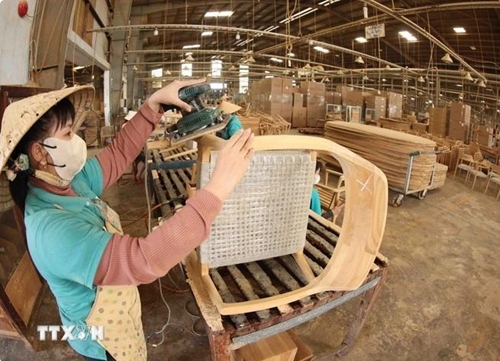To stay competitive and mitigate trade risks, Vietnamese exporters are being urged to improve supply chain governance, embrace green production standards, and invest in sustainable development.
According to trade analysts, policy shifts in major markets such as the U.S. and the E.U. can reshape the landscape for wood and timber product exports. The U.S. is expected to implement stricter trade protection measures in 2025, adding pressure on Vietnamese exporters, who currently send over 50% of their wood-related exports to the American market. As Vietnam stands as the U.S.’s fourth-largest export market in ASEAN and its eighth-largest global trading partner, the stakes are high.
    |
 |
|
Production of indoor and outdoor wooden furniture for export to the U.S., Japan, the Republic of Korea, and Middle Eastern markets at Hiep Long Furniture Manufacturing Company, An Phu ward, Thuan An town, Binh Duong province |
Concerns are growing over the risk of punitive tariffs or trade barriers if exporters cannot meet strict traceability requirements. U.S. protectionist policies may also intensify competition from local producers and alternative suppliers, putting further strain on Vietnam’s timber sector.
In the E.U. the recently extended E.U. Deforestation Regulation (EUDR) poses a similar challenge. Now scheduled to come into effect at the end of 2025 for large companies and mid-2026 for small and medium-sized enterprises, the regulation bans the import of products linked to deforestation. While the delay gives Vietnamese businesses more time to adjust, experts warn that compliance will require substantial improvements in monitoring and certification of forest resources.
Beyond individual markets, the potential for broader trade disputes or disruptions to global supply chains could further impact Vietnam’s wood product exports. This makes agility and preparedness a top priority for industry stakeholders.
The Vietnam Timber and Forest Product Association (VIFOREST) has identified both opportunities and challenges ahead. It noted that global trends favor sustainable materials in construction and interior design, creating new prospects for Vietnamese wood exporters that can meet eco-conscious demand.
Vietnam currently harvests between 22 to 23 million cubic meters of plantation timber annually, with over 500,000 hectares of forests certified for sustainable management. The government’s forestry development strategy sets a target of 1 million hectares of certified forests by 2030.
According to Tran Quang Bao, Director General of the Forestry and Forest Protection Department under the Ministry of Agriculture and Rural Development, strengthening raw material areas is key to achieving long-term sustainability. This includes expanding large timber plantations and forests certified by FSC or PEFC standards. In the short term, pilot programs to assign traceability codes to forest areas in Northern provinces are underway and expected to be rolled out nationwide.
These traceability codes are seen as a cornerstone for developing a legal timber supply chain that aligns with international requirements. They also support Vietnam’s efforts to quantify carbon sequestration potential, contributing to climate goals.
Ngo Sy Hoai, Vice Chairman and Secretary General of VIFOREST, emphasized that competitiveness is vital to survival in the current environment. He noted that both the government and private sector are stepping up efforts to promote sustainable forest certification and adopt advanced traceability technologies. These systems enable full transparency from harvest to transportation and final consumption.
Digital transformation is another critical component. Exporters are encouraged to invest in digital supply chain management, improve product design and branding, and adopt environmentally compliant production processes. Ensuring legal origins, meeting design preferences, and offering competitive pricing will be essential to maintaining and growing market share.
Equally important is the need for coordinated response mechanisms to address the growing use of trade defense tools such as anti-dumping investigations and technical trade barriers. Close cooperation between businesses, industry associations, and government agencies is seen as essential to navigating the evolving regulatory landscape.
One of the key tools in this regard is the verification of product origin, which helps prevent trade fraud and supports compliance with importing countries’ rules. Legal capacity building, risk management improvements, and adherence to international environmental standards are also needed to strengthen Vietnam’s position in global timber trade.
As the industry moves forward, the forestry sector’s efforts to boost sustainability, transparency, and resilience are expected to play a pivotal role not only in meeting its export goals but also in securing its long-term competitiveness in the international market.
Source: VNA